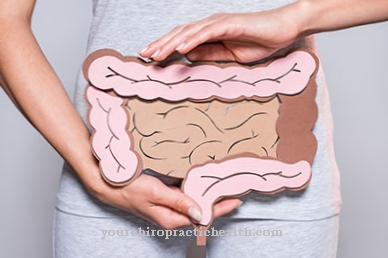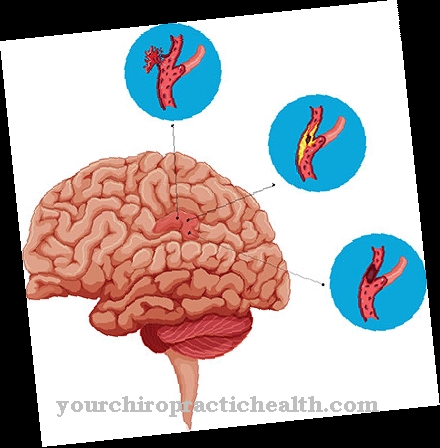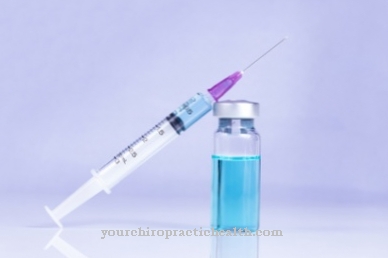A Spinal cord infarction is based on an insufficient blood flow and the resulting undersupply of oxygen and glucose. The consequences are symptoms of paralysis, pain and a disturbed temperature and pain sensation. Treatment is symptomatic or manual therapy.
What is a spinal cord infarction?

© bilderzwerg - stock.adobe.com
An insufficient pathological blood flow due to constrictions or occlusions leads to an undersupply of oxygen and glucose because there is no longer sufficient arterial blood. This undersupply leads to a so-called Spinal cord infarction, also Ischemic myelopathy called.
It should be borne in mind that due to the sometimes low collateral supply to the anterior spinal artery, certain segments of the spinal cord are particularly prone to ischemia. The susceptibility relates to the 2nd and 4th collateral segment. Spinal cord infarction occurs more frequently than through intrinsic disorders of the spinal arteries due to damage to an extravertebral, i.e. feeding artery, or the aorta.
In short: if the blood flow to the spinal cord is stopped by a blocked vessel or a blood clot, the dreaded spinal shock occurs. Even the slightest suspicion of a spinal cord infarction must be treated immediately neurologically or neurosurgery. The consequences of this disease can negatively affect the rest of your life. In the worst case, the spinal cord infarction ends in death.
causes
Aortic dissection and polyarteritis nodosa can be responsible for a spinal cord infarction. Diabetics are also often affected by neurological failures due to a heart attack in the spinal cord. Elderly people are also at risk. These symptoms tend to appear rarely at a young age.
Arteriosclerosis or an embolism can restrict the blood supply to the anterior spinal artery (on the abdomen) and the posterior spinal artery on the dorsal side (on the back). Since they are created in pairs, the cause is less likely to be found here. The fibro-cartilage emboli from the intervertebral discs are considered a special feature and are more likely to be found in young and sporty patients.
However, pregnant women can also be affected. Not to be forgotten are the vascular malformations such as an arterio-venous dural fistula. It can also lead to a heart attack in the spinal canal. Spinal cord infarction is much more common due to obstruction of the arteries caused by tumors, aortic aneurysms, or aortic dissections.
Involvement of the spinal vessels associated with vasculitis should also be considered as a cause. Thrombosis and polyarteritis (vasculitis of the medium-sized arteries) are considered to be the triggering factors.
Symptoms, ailments & signs
Anyone who is about to suffer from a spinal cord infarction (spinalis anterior syndrome) experiences a sudden pain in the back with a ring-shaped radiating tightness. This is not only followed by sensitive failures within a few minutes. Rather, segmental paralysis occurs on both sides.
In addition, the pain and temperature perception is significantly disturbed. These symptoms are based on a lack of or inadequate blood flow, which means that the spinal cord can no longer transmit signals from the brain. On the other hand, the sense of position and vibration as well as the ability to perceive light touches are relatively well preserved.
If it is a small infarct and only affects the tissue furthest from the spinal cord, it can also be a central spinal cord syndrome. Neurological deficits can then regress in the next few days. Because of the variable position of the great radicular artery, such an infarction is known and feared as a complication during an operation on the aorta in the thorax.
Diagnosis & course of disease
The diagnosis is made through an MRI scan. In connection with a CSF examination, other diseases with similar symptoms can be excluded. These include acute transverse myelitis, spinal cord compression and various demyelinating diseases. In most cases, a diagnosis by means of MRI also enables the detection of lesions.
The further course depends largely on where the spinal cord infarction took place. The further it runs up to the cervical marrow, the more body functions are affected and fail. Depending on the arteries affected, the clinical manifestations include the “anterior spinal artery syndrome” and the “posterior spinal artery syndrome”. This is a combination of sensory disturbances, pain and paralysis that usually come on suddenly.
Complications
A spinal cord infarction is an emergency and is a complication of various vascular diseases such as aortic aneurysms, arteriosclerosis or others. If the treatment starts in time, there is a good chance of recovery. This is always possible if the spinal cord is not yet completely damaged. Otherwise there will be permanent damage up to paraplegia. Treatment is based on the underlying disease.
Among other things, emergency operations must be performed on the injured or blocked artery in order to stop bleeding or to remedy the insufficient supply of blood in the event of ischemia. Then symptomatic treatment follows. The healing process takes place depending on the damage to the spinal cord. About 70 percent of the affected patients heal completely.
In around 30 percent of cases, the spinal cord is so badly damaged that a complete healing is no longer possible. The course of a spinal cord infarction also depends on the blood vessels affected. The so-called anterior spinal artery syndrome is characterized by a difficult and complicated course.
This syndrome is caused by a circulatory disorder in the anterior spinal artery. A spinal shock occurs with incomplete paralysis of both legs, which lasts for several months. The pain and numbness are mostly belt-shaped. Furthermore, there are rectal and bladder disorders. As a complication, severe pressure sores of the skin occur, which can lead to necrosis.
When should you go to the doctor?
The dreaded ischemic myelopathy can lead to paralysis, significantly impaired temperature and pain perception, as well as severe, ring-shaped radiating pain in the back. Since the cause lies in a sudden circulatory disorder of the spinal cord, there is an acute danger. The doctor's visit is to be made immediately. If the spinal cord infarction occurs as a result of an operation on the thorax, the patient is already in medical hands.
The spinal shock, which can result from a blocked vessel, requires immediate treatment. If left untreated, it can have dramatic consequences that reduce the quality of life or lead to death. The patient should be presented to a neurologist immediately or transferred to neurosurgery. A spinal cord infarction is a potentially fatal incident which, because of the serious consequences, does not allow any time delay.
A typical spinal cord infarction - also known as anterior spinal syndrome - is severe back pain that is accompanied by a ring-shaped feeling of tightness. Immediately afterwards there are loss of sensitivity and symptoms of paralysis on both sides.
In addition, a significant perception disorder in terms of pain or temperature can be diagnosed. The emergency doctor should be notified immediately, as the damaged spinal cord can no longer transmit signals. A distinction must be made between small and large spinal cord infarctions. In the case of central spinal cord syndrome, the neurological deficits can regress after a few days.
Treatment & Therapy
The best therapeutic success arises, of course, when the spinal cord has not been completely destroyed and has only ceased to function. Regeneration can be achieved with targeted exercise therapy lasting several weeks. If it is known that an aortic dissection or polyartritis nodosa is the cause, the primary aim is to treat these secondary diseases. Symptomatic treatment is indicated in most cases.
If the MRI reveals masses, surgical decompression must be initiated immediately. In most cases, subsequent treatment is symptomatic. However, it can also be based on the treatment measures that are usual for a cross-sectional lesion.
The primary aim is to ensure that vital functions are still present or to restore them. Experienced and specialized physiotherapists and occupational therapists are the competent contacts for this. Special physiotherapeutic exercises are used in order to preserve remaining mobility and, if necessary, to improve it.
The TENS treatment and foot reflexology treatments have also proven their worth. In this way, the dreaded muscle shortening and stiffening can be counteracted. It is not uncommon for patients to sit in a wheelchair at the beginning of this type of therapy or need aids such as a walking stick or two or a walker.
This is accompanied by neurological check-ups at regular intervals. These are necessary to avoid secondary consequential damage as far as possible. Then it is important to treat the cause.
prevention
The most important preventive measure to avoid a spinal cord infarction is to stabilize the back muscles. This can be done through age-appropriate sport that is practiced continuously. Swimming, floor exercises (gymnastics) and light, adapted strength exercises are recommended in this context.
Aftercare
Those affected have to undergo rehabilitation measures immediately after a spinal cord infarction. Thanks to the special therapy, most people can move as they did before the spinal cord infarction. Sufferers should regularly do physiotherapy and occupational therapy exercises at home to improve their health. In addition, you should avoid any kind of stress and strain.
Those affected need sufficient rest and rest, especially in the first few weeks. Treatable drugs can speed healing. Globulis and pain relieving and calming teas are recommended. In addition, the diet should be changed and thus adapted after the spinal cord infarction. Those affected should eat a very healthy diet and consume plenty of fruit and vegetables.
In addition, the food should be very rich in vitamins. If those affected are addicted to alcohol or cigarettes, it is advisable to contact an addiction counseling service. Do not consume such agents, as this can lead to a spinal cord infarction again.
If the spinal cord infarction had to be operated on, those affected are then dependent on a wheelchair or crutches. In this case, the help and support of family and relatives is needed, as those affected can hardly move. Help from relatives with everyday tasks is also needed.
You can do that yourself
Rehabilitation measures must be started early after a spinal cord infarction. Appropriate therapy stimulates the muscles and patients can often move as they did before. Part of the treatment are physiotherapy and occupational therapy exercises that those affected can do at home. At the same time, however, care should also be taken to take sufficient care. The back needs rest, especially in the first days and weeks after a heart attack.
The patient can take homeopathic or household painkillers, thereby promoting recovery. Globules, but also pain-relieving teas with extracts of chamomile or lemon balm, have proven their worth. In addition, diet should be adjusted after a spinal cord infarction. The most causal circulatory disorder of the spinal cord is due to a one-sided diet. Accordingly, a balanced diet with lots of fruit and vegetables is important after a medical emergency. Smokers and alcoholic people are best contacted with an addiction counseling service. The triggers have to be eliminated, otherwise the infarction can occur again.
Normal movement is usually not possible after an operation on the spinal cord. The patient is dependent on crutches or a wheelchair, which must be organized at an early stage. He also needs the help of relatives and friends who should provide support in the difficult time. The doctor responsible must decide which accompanying measures are useful in detail.



.jpg)
.jpg)

.jpg)










.jpg)







.jpg)


